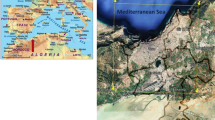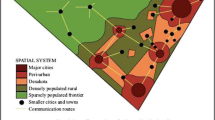Abstract
Sharjah is the third largest and populous city in the United Arab Emirates (UAE). It is located along the northern coast of the Persian Gulf on the Arabian Peninsula. Throughout the past few decades, Sharjah City has witnessed massive growth in its urban area and infrastructure facilities. Transportation infrastructure, in particular, is a key indicator of growth and development of the city. Transportation is a vital component of the economy and prosperity of any city as it provides easy access to land, moves large volumes of people and vehicles, enables larger markets, and saves time and costs. Recent advances in satellite imagery, in terms of improved spatial and temporal resolutions, are allowing for efficient identification of change patterns and the prediction of areas of growth. This paper aims to quantify and analyze the spatial–temporal relationship between urban growth and the transportation development that took place at Sharjah City from 1976 until 2014. For growth detection and quantification, linear features extracted automatically from multi-temporal Landsat registered images were adopted as the basis of change detection where pixel-to-pixel subtraction has been implemented. Linear features were also chosen for image registration since they can be reliably extracted from imagery with significantly different geometric and radiometric properties. Digitized features of building and roads have been used as ground-truth of the adopted algorithm. Preliminary results show that the range of growth represented by linear features (building and roads) that occurred during the 1976–2014 period accounts for about 33% of the total area inside Sharjah City.
Access provided by CONRICYT-eBooks. Download conference paper PDF
Similar content being viewed by others
Keywords
1 Introduction
Transportation is key to promoting economic prosperity and urban development. Transportation system provides access to business activities, employment, education, and recreational opportunities. As such, the adequacy of transportation infrastructure , whether it is roadways or transit, has a great impact on any city’s development and on maintaining socially acceptable levels of quality of life. As an urban area develops, its transportation system grows in parallel. In fact, the expansion of transportation infrastructure is often observed as synonymous to urban growth.
Over the past four decades, Sharjah City, the third largest city in the UAE, has witnessed a massive growth in its population, urban area, and infrastructure. For example, the population of Sharjah has increased almost tenfold between 1975 and 2005 (Wikipedia 2016). Since urban growth varies spatially, it is of interest to officials and researchers alike to quantify and trace the spatial growth of the City over time. The main purpose of this study is to detect urban infrastructure growth and development in Sharjah City by detecting and registering linear features in multi-temporal Landsat images.
Change detection is the process of identifying differences in the state of an object or phenomenon by observing it at different times (Singh 1989). Multi-spectral and multi-resolution images captured by various sensors were used to quantify changes at different times. Numerous change detection methods have been illustrated and described in the literature. These methods adopted different algorithms that basically depend on image subtraction, image ratio, change vector analysis, principle component analysis, neural network, or morphological mathematics (Al-Ruzouq and Habib 2012; Bruzzone and Prieto 2000; Dowman 1998; Singh 1989).
Image registration can be defined as the process that can be used in order to geometrically aligning multi-spectral and multi-resolution images where same features in different images are belonging to each other. This process required major elements. First; Registration primitives (points, lines or polygons), second; appropriate transformation function and matching strategy. Accurate image registration is essential prerequisite for accurate change detection where changes in multi-spectral and multi-resolution images belongs to real changes rather than changes resulted from miss registration process.
In this paper linear features extracted from roads, affine transformation function and Modified Iterated Hough Transform (MIHT) (Habib and Al-Ruzouq 2004; Habib and Kelley 2001a, b) were adopted as base for a registration methodology.
2 Study Area
Sharjah City is the largest city and the seat of the Emirate of Sharjah in the United Arab Emirates (UAE). It is located in a dry hot region, with daily high temperatures of 24–42 °C and daily main temperature of 18–34 °C. The rainy months are typically December to February, with an average rainfall of approximately 100 mm/year. The rainfall in dry years does not generally exceed 40 mm/year but can reach up to 200 mm/year in heavy-rain years. The City of Sharjah is located along the northern coast of the Persian Gulf on the Arabian Peninsula with central coordinates of 25.3°N 55.5°E. Figure 1a–c show the UAE map, Landsat image of Emirate of Sharjah, and the study area (136.27 km2) within Sharjah City, respectively.
3 Geospatial Data
Multi-source, multi-resolution, and multi-temporal imagery for the City of Sharjah were used in this study. The diverse satellite images with different radiometric and geometric resolutions were captured in different years. These data will be used for image registration and change detection. Table 1 lists the source of each image including source and year of capturing the image as well as its spatial resolution in meters. Figure 2 shows sample of the Landsat images for the study area for years 1976 and 2010.
In addition to Landsat images, Google Earth images have been captured with high resolution. Coverage within each image was minimized during capturing to ensure high resolution images. Five images were captured and geo-referenced to cover the study area. Figure 3 shows sample of mosaic Google Earth images with 3.0 m ground resolution. This resolution would allow for accurate digitizing of linear features as described in the following section.
In addition to the above-described raster data, vector data, such as land use and roadway network data, have been prepared. As an example, Fig. 4 shows land-use classification for the study area in Sharjah City. Land-use classes considered include industrial, educational, residential, high-rise buildings, and mixed use.
4 Analysis
In this study, two basic approaches were applied and followed to detect urban growth and change for the study area within Sharjah City. The first approach rely on image processing techniques and accurate image registration procedure using multi-temporal Landsat satellite images with ground resolution varying between 15 and 60 m. The second approach relies on digitizing features from high-resolution Google images captured at different years, where various land-use classes were established to facilitate the growth development analyses.
4.1 First Approach
Figure 5a shows the resampled images after applying previous transformation where corresponding pixels are pointing at the same object space feature. It has to be mentioned that radiometric differences and noise among images were reduced by applying various image processing techniques (Al-Ruzouq and Habib 2012; Cavallaro and Touradj 2001; Agouris et al. 2000; Canny 1986). Figure 5b shows a sample of derived edges for the study area at different years where a simple pixel-by-pixel subtraction between the resampled edge images was used to extract changing pixels. The filtered images emphasized areas with interesting features since they would lead to a dense distribution of edge cells. Afterward, the filtered images were subtracted to highlight areas of change. Figure 6 shows the difference image from 1987 until 2010. In the difference image, white areas indicate changes while black areas indicate parts with no change. From the visual inspection of Fig. 6, it can be clearly noticed that areas where change have occurred are represented by white pixels. AL-Ruzouq and Shanableh (2014) illustrated that the highest range of growth represented by linear features (building and roads) was accrued between 1976 and 1987, which consists of 36.24% of the total urban features in Sharjah City. Moreover, the result showed that between 1976 and 2010, the cumulative urban expansion inside Sharjah City is 71.9% (Al-Ruzouq and Shanableh 2014).
4.2 Second Approach
In this stage, multi-temporal Google Earth images were used to digitize various features. The features were classified into the following nine different classes: Roads, Buildings, Paved Parking, Compacted Soil, Undisturbed Soil, Green Area, Water, and Others. Figure 7 shows the digitized features from the 2004 geo-referenced Google Earth image.
Figure 8 shows the digitized roads for the study area for the years 2004 and 2014. The expansion of the road and street network can be easily visualized in the newly developed parts of the study area at the lower right corner. Simple calculation of polygons areas for linear features of roads and buildings show that the range of growth represented by linear features (building and roads) that occurred during the 1976–2014 period accounts for about 33% of the total area inside Sharjah City.
5 Conclusion
This paper presents an image registration together with a suggested procedure for detecting urban development changes from imagery. The proposed approach has been tested on a real-world setting, which showed its effectiveness in registering and detecting changes among multi-temporal and multi-resolution imagery. Digitized features based on geo-referenced Google Earth images were extracted to work as ground truth for the study area. Future research will concentrate on using high-resolution images for change detection and simultaneously establishing ground truth for quantitative evaluation of the proposed approach.
References
Agouris P, Mountrakis G, Stefanidis A (2000) Automated spatiotemporal change detection in digital aerial imagery. In: SPIE proceedings 4054:2–12
Al-Ruzouq R, Habib A (2012) Linear features for automatic registration and reliable change detection of multi-source imagery. J Spat Sci 57(1):51–64 (Taylor & Francis)
Al-Ruzouq R, Shanableh A (2014) Multi-temporal satellite imagery for urban expansion assessment at Sharjah city/UAE. Malays J Remote Sens GIS 3(2):76–83
Bruzzone L, Prieto D (2000) Automatic analysis of the difference image for unsupervised change detection. IEEE Trans Geosci Remote Sens 38(3):1171–1182
Canny J (1986) A computational approach to edge detection. IEEE Trans Pattern Anal Mach Intell 6(6):679–698
Cavallaro A, Touradj E (2001) Change detection based on color edges. In: Proceedings of IEEE international symposium on circuits and systems (ISCAS-2001)
Dowman I (1998) Automated procedures for integration of satellite images and map data for change detection: the archangel project. GIS-between visions and applications. IAPRS 32(4):162–169
Habib A, Al-Ruzouq R (2004). Line-based modified iterated hough transformation for automatic registration of multi-source imagery. Photogram Rec 19(105):5–21
Habib A, Kelley D (2001a) Automatic relative orientation of large scale imagery over urban areas using modified iterated hough transform. Int J Photogram Remote Sens 56(2001):29–41
Habib A, Kelley D (2001b) Single photo resection using the modified hough transform. J Photogram Eng Remote Sens 67(2001):909–914
Singh A (1989) Review article digital change detection techniques using remotely-sensed data. Int J Remote Sens 10(6):989–1003
Wikipedia (2016) Demographics of the United Arab Emirates. Available at: https://en.wikipedia.org/wiki/Demographics_of_the_United_Arab_Emirates (online). Accessed 21 Sept 2015
Author information
Authors and Affiliations
Corresponding author
Editor information
Editors and Affiliations
Rights and permissions
Copyright information
© 2017 Springer International Publishing AG
About this paper
Cite this paper
Al-Ruzouq, R., Hamad, K., Shanableh, A. (2017). Spatiotemporal Analysis and Image Registration for Studying Growth of Transportation Infrastructure in Sharjah City, UAE. In: Pirasteh, S., Li, J. (eds) Global Changes and Natural Disaster Management: Geo-information Technologies . Springer, Cham. https://doi.org/10.1007/978-3-319-51844-2_9
Download citation
DOI: https://doi.org/10.1007/978-3-319-51844-2_9
Published:
Publisher Name: Springer, Cham
Print ISBN: 978-3-319-51843-5
Online ISBN: 978-3-319-51844-2
eBook Packages: Earth and Environmental ScienceEarth and Environmental Science (R0)












